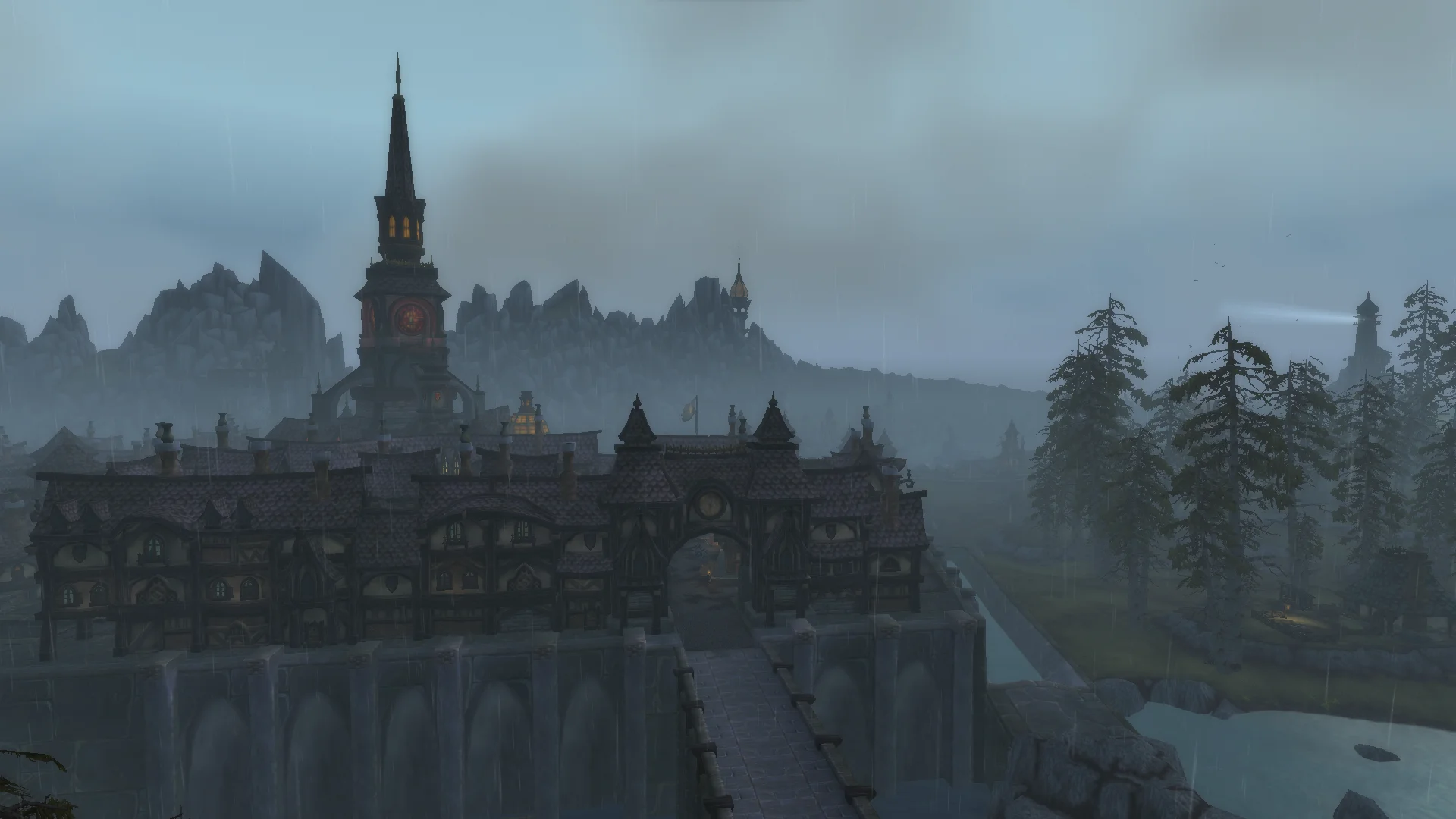
Location: Gilneas
BackIntroduction to Gilneas
Gilneas, a kingdom shrouded in mystery and tragedy, stands as a testament to the complex history woven into the fabric of Azeroth. Nestled behind the imposing Greymane Wall, this isolated land was once a maritime powerhouse, thriving on innovation and self-sufficiency. However, the decision to close itself off from the rest of the world marked a turning point in Gilneas' fate, setting the stage for a series of cataclysmic events.
Led by the indomitable Genn Greymane, Gilneas faced not only external threats, such as the Forsaken invasion orchestrated by Sylvanas Windrunner, but also internal strife in the form of the resurfacing Worgen curse. As political tensions escalated into a full-blown civil war, the once-proud kingdom became a battleground for conflicting ideologies and the struggle for survival.
Explore the multifaceted layers of this kingdom's narrative, where isolationism, curses, and war converge to shape the destiny of its people and leave an enduring mark on the history of Azeroth.
Isolation and the Greymane Wall
Genn Greymane's decision to isolate Gilneas and build the Greymane Wall stemmed not only from nationalism but also from a deep-seated fear of the outside world. The kingdom's self-imposed isolation was a response to the growing threat of the Scourge and other external dangers. The Greymane Wall, in addition to its symbolic significance, was a marvel of engineering, showcasing Gilneas' commitment to its isolationist policies. However, this isolation came at a cost, as the kingdom became ignorant of the changing dynamics in the Eastern Kingdoms.
The isolation also affected Gilneas' cultural and economic exchanges, leading to a decline in knowledge about developments beyond the wall. The kingdom's once-thriving trade relationships with neighboring regions dwindled, impacting its access to crucial resources and innovations. The Greymane Wall became a double-edged sword, both protecting and isolating Gilneas from the rest of Azeroth.
Forsaken Invasion
Sylvanas Windrunner's strategic brilliance was evident in her decision to target Gilneas. Beyond its strategic location and shipyards, Gilneas held a personal significance for Sylvanas due to her history with the Arugal-led Worgen and the Scythe of Elune. The Forsaken invasion not only sought military dominance but also aimed to secure a foothold for Sylvanas in her quest for power. The unintended awakening of the Worgen curse added a layer of complexity to the Forsaken's plans, turning their conquest into a chaotic struggle for control.
The Forsaken invasion, with the deployment of the Plague, not only targeted military objectives but also had far-reaching consequences on Gilneas' environment. The once-idyllic landscapes were tainted, and the flora and fauna were affected, further emphasizing the ecological impact of the Forsaken's actions on the kingdom.
The Worgen Curse
The Druids of the Scythe's attempts to control the primal fury of the Worgen were rooted in a desire to harness a formidable force for Gilneas' defense. However, the unintended consequences of their actions led to the curse spreading uncontrollably. The psychological impact of the curse on those afflicted delved into themes of identity and inner conflict. The resurgence of ancient druidic traditions in response to the curse raised ethical questions about the consequences of manipulating nature for mortal gains.
The Worgen curse also had a profound impact on Gilneas' medical and magical research. Scholars and healers grappled with the challenge of understanding and curing the curse, leading to the establishment of new schools of thought and the emergence of specialists dedicated to Worgen-related studies.
The Gilnean Civil War
The civil war within Gilneas exposed deep-seated societal divisions. The embrace or rejection of the Worgen curse became a focal point, reflecting differing perspectives on strength and weakness. Class disparities were magnified, with the nobility experiencing the curse differently than the common folk. The political upheaval during the civil war laid the foundation for a transformed Gilneas, where the consequences of the Worgen curse were not only physical but also permeated the kingdom's social fabric.
The aftermath of the civil war also saw the rise of new political factions and ideologies within Gilneas. The scars of the conflict led to ongoing debates about the kingdom's future, with some advocating for reconciliation and unity, while others sought to maintain the status quo or push for radical changes in governance.
The Battle for Gilneas City
The Battle for Gilneas City was a harrowing clash of magical and medieval forces. The ancient architecture of the city became a backdrop to the chaos, with each district presenting unique challenges for both Forsaken and Worgen forces. The battle showcased not only the military prowess of the Gilnean people but also the devastating toll of war on their once-majestic city. The scars left by the conflict would serve as a lasting reminder of the price paid for Gilneas' isolationist policies.
The magical residue left in the wake of the battle had lingering effects on Gilneas City, creating areas tainted by dark magic. These regions became sources of mystical disturbances, attracting the attention of scholars, mages, and adventurers seeking to understand and contain the magical aftermath of the conflict.
The Fall of Gilneas
The fall of Gilneas marked a turning point in the kingdom's history. The displacement of citizens and the Forsaken occupation led to radical societal changes. Those who resisted faced persecution, and the Forsaken's influence altered the cultural landscape of Gilneas. The kingdom's downfall served as a cautionary tale about the consequences of isolationism, the dangers of meddling with ancient curses, and the ever-present threat of war in Azeroth. The dispersal of Gilnean refugees became a poignant narrative thread woven into the broader tapestry of World of Warcraft's evolving storyline, illustrating the far-reaching consequences of a once-proud kingdom's fall.
The diaspora of Gilnean refugees also had ripple effects across Azeroth, as displaced individuals brought their stories and struggles to new lands. The resilience of the Gilnean people, faced with adversity, became an inspiration for other communities grappling with the aftermath of war and conflict.
Tempest's Reach
Nestled along the rugged coast of Gilneas, Tempest's Reach is a beacon of resilience amidst the stormy seas. With its imposing cliffs and crashing waves, the town stands as a testament to the indomitable spirit of the Gilnean people. Tempest's Reach has weathered both natural disasters and the ravages of war, emerging as a symbol of steadfastness against adversity.
Tempest's Reach, strategically positioned on the coast, serves as a vital maritime hub for Gilneas. Its shipyards are crucial for maintaining the kingdom's naval strength. The town is known for its skilled shipwrights and seafaring traditions. Its strategic location facilitates trade and communication with other coastal settlements, contributing to Gilneas' economic stability.
The Blackwald
The Blackwald, a foreboding and ancient forest, blankets the landscape with a canopy of dark, twisted trees. Within its depths, whispers of ancient curses linger, and eerie shadows dance between the gnarled branches. The Blackwald is a realm of mystery and danger, where the line between the living and the supernatural blurs.
The Blackwald, once a thriving woodland, fell victim to the Worgen curse and the Forsaken invasion. The cursed woods harbor not only Worgen but also other supernatural entities. The dense foliage and twisted paths make navigation treacherous, and rumors persist of ancient artifacts hidden within its depths. Adventurers brave enough to explore may uncover forgotten secrets and face the spectral inhabitants of this haunted forest.
Stormglen Village
Nestled at the edge of Gilneas, Stormglen Village exudes an air of tranquility despite the turmoil that has befallen the kingdom. The cobblestone streets and quaint cottages echo with the resilience of the Gilnean people. Stormglen, though scarred by the Worgen curse, stands as a testament to the determination of its inhabitants to rebuild and reclaim normalcy.
Stormglen Village, once a bustling community, is now on the path to recovery after the effects of the Worgen curse. The village plays a crucial role as a focal point for rebuilding efforts in the region. Its central location makes it a gathering place for survivors and a hub for trade and commerce. Despite its scars, Stormglen Village represents the unwavering spirit of Gilneans in the face of adversity.
Duskhaven
Duskhaven, a once-prosperous coastal town, now bears the scars of the tumultuous events that unfolded in Gilneas. The echoes of the Forsaken invasion and the resurgence of the Worgen curse resonate through its cobblestone streets. Duskhaven's dilapidated buildings and somber atmosphere tell a tale of a community grappling with the aftermath of war and supernatural upheaval.
Despite its hardships, Duskhaven remains a focal point for Gilnean survivors seeking refuge and solidarity. The town's strategic location and historical significance make it a poignant symbol of the challenges faced by the kingdom. As Duskhaven rebuilds, its inhabitants strive to reclaim a sense of normalcy and unity.
Greymane Manor
Greymane Manor, an architectural marvel at the heart of Gilneas City, stands as a testament to the kingdom's noble heritage. The imposing structure, with its Gothic spires and intricate detailing, reflects the grandeur of Gilneas' aristocracy. Greymane Manor has weathered the ages, witnessing the rise and fall of the kingdom, from prosperity to the challenges of isolationism and war.
The manor holds a central role in the political and social fabric of Gilneas. As the seat of House Greymane, it has been both a place of opulence and a stronghold during times of conflict. The halls of Greymane Manor echo with the footsteps of the kingdom's history, encapsulating the struggles and triumphs of its people.
Aderic's Repose
Aderic's Repose, a solemn graveyard nestled within the shadow of Gilneas City, serves as the final resting place for generations of Gilneans. The gravestones, weathered by time and adorned with faded inscriptions, tell the stories of the kingdom's past. The atmosphere is one of quiet reflection, as the deceased find peace beneath the ancient trees that stand as silent sentinels.
The cemetery holds a sacred place in Gilnean culture, a site where families come to honor their ancestors and pay respects to those who have fallen in the line of duty. Aderic's Repose is not only a burial ground but a poignant reminder of the cost of war, the weight of history, and the resilience of a kingdom that endures.
Gilneas City
Gilneas City, the heart of the Gilnean kingdom, is a sprawling metropolis that blends medieval architecture with mystical aesthetics. Its towering walls and intricate structures tell the tale of a city that has witnessed both prosperity and the ravages of war. The city's districts are a mosaic of culture, reflecting the diversity of its inhabitants.
Once a beacon of unity, Gilneas City became a battleground during the Forsaken invasion and the Worgen curse. The scars of conflict are etched into its streets, but the city remains a symbol of Gilneas' resilience. As the kingdom rebuilds, Gilneas City stands as a testament to the enduring spirit of its people.
Keel Harbor
Keel Harbor, a bustling maritime hub on the western coast of Gilneas, is known for its vibrant seafaring culture and bustling trade activities. The harbor's docks teem with ships, from fishing vessels to naval warships, showcasing Gilneas' historical connection to the seas.
Despite its maritime prosperity, Keel Harbor faced the brunt of the Forsaken invasion. The harbor became a strategic target, and its waters witnessed fierce naval battles. As the kingdom recovers, Keel Harbor plays a pivotal role in rebuilding Gilneas' naval strength and re-establishing connections with other coastal settlements.
The Headlands
The Headlands, a rugged expanse along Gilneas' northern coast, offers breathtaking vistas and untamed landscapes. Cliffs and rocky shores give way to sweeping views of the open sea, making it a region of natural beauty and solitude.
Despite its scenic charm, The Headlands bore witness to the chaos of war. The Forsaken invasion and the Worgen curse left their mark on this once-pristine region. As nature reclaims its spaces, The Headlands become a poignant reminder of the delicate balance between the kingdom's natural beauty and the tumultuous events that shaped its history.
Northern Headlands
The Northern Headlands, an extension of the rugged northern coast of Gilneas, is a region where the wild beauty of nature meets the remnants of ancient civilizations. Cliffs and windswept plateaus provide a dramatic backdrop to the ongoing struggles faced by the Gilnean people.
The Northern Headlands, like the rest of Gilneas, experienced the consequences of isolationism and war. Ruins of ancient structures and mystical sites dot the landscape, revealing glimpses of the kingdom's rich history. As adventurers explore this untamed expanse, they uncover the stories of the past and the challenges that lie ahead for Gilneas.
Northgate Woods
Northgate Woods, a verdant forest on the outskirts of Gilneas City, once stood as a serene haven. The whispering leaves and ancient trees created a tranquil atmosphere, providing respite for those seeking solace in nature.
However, the woods bore witness to the chaos of the Worgen curse. The once-peaceful groves became the battleground for Gilneans grappling with the effects of the curse. The Northgate Woods, though scarred by conflict, remain a vital part of Gilneas' natural heritage, awaiting the day when the balance between civilization and nature can be restored.
Emberstone Mine
Emberstone Mine, a subterranean labyrinth beneath the Gilnean landscape, was once a rich source of valuable minerals that fueled the kingdom's industry. The mine's tunnels delve deep into the earth, echoing with the sounds of pickaxes and the glow of precious gemstones.
However, Emberstone Mine became a site of both economic prosperity and later, conflict. The Forsaken invasion and the internal strife during the Gilnean Civil War left the mine abandoned and its tunnels fraught with danger. As the kingdom looks to rebuild, Emberstone Mine stands as a testament to the delicate balance between the riches of the earth and the price paid for them.
Factions in Gilneas
- Gilnean Refugees: Displaced citizens seeking safety and a new way of life in the aftermath of Gilneas' fall.
- Forsaken Occupiers: The undead forces of the Forsaken, controlling and restructuring Gilneas according to Sylvanas Windrunner's vision.
- Worgen Allies: Those who embrace the Worgen curse as a source of strength and fight for a different future for Gilneas.
- Gilnean Nobility: The remnants of the noble houses, grappling with the changing social and political landscape.
- Scarlet Crusade Infiltrators: Agents of the Scarlet Crusade seeking to exploit the chaos in Gilneas for their own ends.
- Neutral Survivors: Individuals and groups trying to navigate the complexities of the conflict without aligning with major factions.
Creatures in Gilneas
- Worgen: Cursed individuals transformed into fierce wolf-like creatures, a manifestation of the ancient Worgen curse.
- Undead: Forsaken forces led by Sylvanas Windrunner, including skeletons, ghouls, and other undead minions.
- Blackwald Spiders: Monstrous spiders inhabiting the dark forests of Gilneas, posing a threat to unwary travelers.
- Cursed Wildlife: Animals and wildlife affected by the magical fallout of the Worgen curse, exhibiting unnatural and aggressive behavior.
- Scarlet Crusaders: Fanatical members of the Scarlet Crusade infiltrating Gilneas, bringing their zealous aggression to the conflict.
- Elementals: Mystical beings summoned or influenced by the magical disturbances in Gilneas, adding an elemental threat to the region.
Conclusion: Legacy of Gilneas
The fall of Gilneas marks a poignant chapter in the history of Azeroth, leaving behind a legacy of isolation, internal strife, and external invasions. Genn Greymane's decision to isolate the kingdom behind the formidable Greymane Wall, driven by a fervent sense of nationalism, inadvertently set the stage for the Forsaken invasion and the resurgence of the Worgen curse.
The Forsaken, under Sylvanas Windrunner, sought Gilneas not only for strategic advantage but also for its shipyards, unleashing unintended consequences with the reawakening of the Worgen curse. The subsequent civil war, the Battle for Gilneas City, and the eventual fall of Gilneas brought about cultural upheaval and displacement.
The diaspora of Gilneans serves as a narrative thread, a reminder of the consequences of isolationism and the ever-present specter of war that looms over Azeroth. As refugees disperse, the echoes of Gilneas reverberate across the Eastern Kingdoms, adding a complex layer to the evolving storyline of World of Warcraft.
The legacy of Gilneas is one of resilience, adaptation, and the indomitable spirit of its people amidst the challenges of curses, invasions, and internal conflicts. It stands as a cautionary tale and a testament to the enduring impact that individual decisions can have on the fate of nations.
Recommended content
Silithus
Explore the mysteries and challenges of the Silithus zone in World of Warcraft.
Eastern Plaguelands
Discover the haunted landscapes and stories of Eastern Plaguelands in World of Warcraft.
Genn Greymane
Learn about Genn Greymane, the leader of the worgen and his role in Warcraft lore.
Darkshore
Explore the dark and mysterious Darkshore zone in the world of Azeroth.

